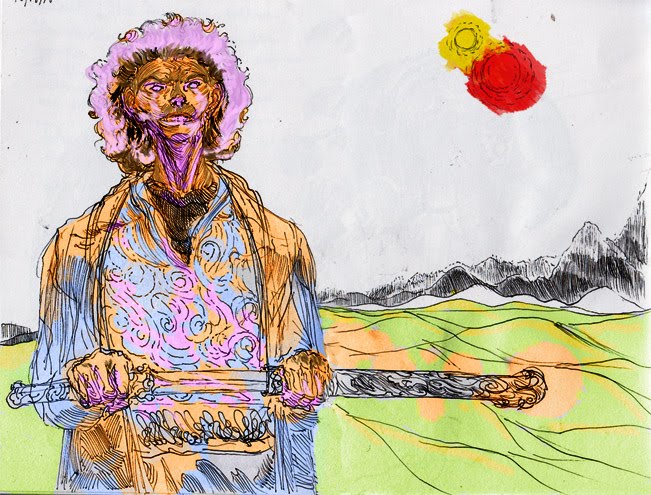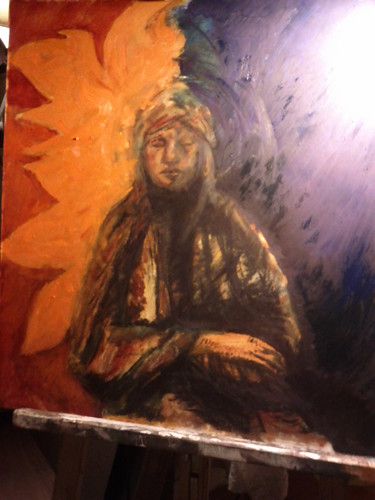Some ok pics of a recent commission I've been working on, it's just about done now minus some small details and touching up. It was different working on a portrait of a child since the feature are soft especially for how I draw most of the times, I left ink entirely out of this one. Some areas of it work nicely, also learned a few new ways to do things. I may have more lined up the future since folks who come through my house see my art usually start asking for something to be done. Who would have thought constantly doing art since last summer to know would have an effect like on folks, so far I have done three commissions over the last couple of months.
Thursday, March 29, 2012
Portrait of a baby
Labels:
acrylic,
baby,
conte,
drawing,
matte medium,
pencil,
portrait,
watercolor
Thursday, March 22, 2012
Sketchy fella
Been a little while since I posted some sketches, but I have been sketching like it's going out of fashion.
Monday, March 19, 2012
Art of Jamaica
The Art of Jamaica: as Freespirited as the Music
Like its music, Jamaican art carries influences from a range of cultures and places. Like its music, it is often vibrant and dynamic, telling the story of the island's people both in a historical or political sense, and a gentler, more human one. Jamaican art often depicts the the natural landscape of the island, as well as the human one. Jamaica is many things, from a place of slavery to a destination for Caribbean cruises. Like the art of any country, Jamaican art doesn't have any one school or style. In the twentieth century, Jamaican artists have worked within many of the more mainstream schools of that time, such as realism or cubism. Jamaican art continues to absorb influences both from within itself and the outside world, and to reflect the island's cultural history and present.
Early Jamaican Art
In its earliest form, Jamaican art was the art of the indigenous people of the area, the Taino. Their culture was largely lost after colonisation across the West Indian islands in which they lived. Their art was rich in symbolism, and reflected the social and religious beliefs of the people. Their art was mainly the the form of cave paintings and in carvings of both people and animals, and represented aspects of their lives and their gods. The Jamaican National Gallery holds some Taino woodcarvings.
The Colonial Era
Jamaican art from the sixteenth century onwards reflected the changing nature of the island. With European colonisation, the islands became home to British, French, Spanish, African and Asian people. While the Europeans vied for power, the African and Asian people were slaves and indentured labourers. It was the Europeans who created the only sale-able art from Jamaica. Even if and when they had the time to create art (and undoubtedly many would have done, as all people do), the slave owners discouraged their slaves from doing anything other than working. Art, amongst slaves, was seen as laziness.
Europeans did create some art during the colonial era, often creating paintings to send back to Europe. Much of it reflects a particular vision of Jamaica and of the colonial world in general, designed to be palatable to Europeans who knew little of life in the West Indies. Their art work was European, rather than Jamaican. Even after the end of slavery, there was little in the way of truly Jamaican art emerging. Visiting European artists would come to the island and would sometimes take on local apprentices, but they were still essentially teaching European-style art.
The Twentieth Century
It was in the twentieth century that a really Jamaican art emerged. Local artists began to work with painting and sculpture to depict their island and their lives, and there was a new energy and confidence about art on the island. As the desire for autonomy and a lessening of colonial ties grew amongst the island's people, so did their art, which was increasingly local. They often drew on African influences, but worked to create new styles.
Edna Manley, a mixed-race sculptor who had grown up in Britain, arrived in Jamaica in 1922. She is often seen as the founder of modern Jamaican art. She had attended London's St Martins College, and had a good understanding of both European artistic schools and the history of the Jamaican people. She saw Jamaican art at that time as staid, and in her words 'anaemic', focussing on European styles rather than being part of a new Jamaican identity. Her best known work is Negro Aroused, which she sculpted in 1935 against a background of increasing unrest and racial consciousness among Jamaicans. It became a symbol of that consciousness and anti-colonialsism.
Edna Manley also worked to encourage local artists, helping to run volunteer art classes in Kingston which helped many local artists become established. Then, in the 1950s and 60s more and more Jamaican artists looked abroad and incorporated influences from the west. Jamaican art began to fragment into those using more traditional forms and those seeking to take on new forms, but it also matured. Both schools retained a strong interest in Jamaican history and culture, and in African iconography. Contemporary Jamaican art can be seen all over the island, in its 30 commercial galleries and in the National Gallery of Jamaica in Kingston.
This article was written by Anna Pullman who contacted me about publishing an article on my blog, it's cool to share some of the history of my island and it's art.
Monday, March 12, 2012
Subscribe to:
Posts (Atom)
















